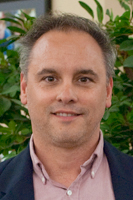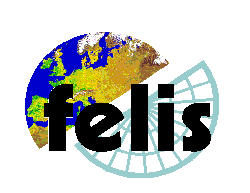Prof. Dr. John Weishampel - Gastprofessor
Prof. Dr. John Weishampel
Department of Biology
University of Central Florida
Orlando, FL 32816 USA
Tel: (407) 823-6634
fax: (407) 823-5769
John.Weishampel@ucf.edu
Aufgaben an der Abteilung
- Gastprofessor
Arbeitsschwerpunkte
- Unterstützung der Abteilung in Forschung und Lehre
Lebenslauf
Berufserfahrung (ab 2006)
5/06 - present Professor, Department of Biology, University of Central Florida, Orlando, FL
8/11 - present Provost’s Fellow, Academic Affairs, University of Central Florida, Orlando, FL
1/08 - 5/08 Interim Graduate Program Coordinator, Department of Biology, UCF, Orlando, FL
2/06 - 7/06 Fulbright Distinguished Research Chair, Dept. of Geography, Simon Fraser University, Vancouver, BC
8/05 - 2/06 Charles Bullard Fellow, Harvard University, Harvard Forest LTER, Petersham, MA
Education
1994 Ph.D. Environmental Sciences (Ecology Track), University of Virginia.
1990 M.S. Environmental Sciences, University of Virginia.
1985 B.S. Biology, Duke University.
Veröffentlichungen und Präsentationen
Peer-Reviewed Journal Publications (39 total; 15 since 2006; graduate and undergraduate students):
1) Chaouch, N., M. Temimi, S. Hagen, J. Weishampel, S. Medeiros, and R. Khanbilvardi. A synergistic use of satellite imagery from SAR and optical sensors to improve coastal flood mapping in the Gulf of Mexico. Hydrological Processes. In Press.
2) Medeiros, S. C., S. C. Hagen, and J. F. Weishampel. Comparison of floodplain surface roughness parameters derived from land cover data and field measurements. Journal of Hydrology. In Press.
3) Weishampel, J. F., J. N. Hightower, A. F. Chase, and D. Z. Chase. 2012. Use of airborne LiDAR to delineate canopy degradation and encroachment along the Guatemala-Belize border. Tropical Conservation Science. 5: 12-24.
4) Weishampel, J.F., J. N. Hightower, A.F. Chase, D.Z. Chase, and R. A. Patrick. Detection and morphologic analysis of potential below-canopy cave openings in the karst landscape around the Maya polity of Caracol using LiDAR. Journal of Cave and Karst Studies. In press.
5) Chase, A. F., D. Z. Chase, J. F. Weishampel, J. B. Drake, R. L. Shrestha, K. C. Slatton, J. J. Awe, and W.E. Carter. 2011. Airborne LiDAR, archaeology, and the ancient Maya landscape at Caracol, Belize. Journal of Archaeological Science 38: 387-398.
6) Chase, D. Z. A. F. Chase, J. J. Awe, J. H. Walker, and J. F. Weishampel. 2011. Airborne LiDAR at Caracol, Belize and the interpretation of ancient Maya society and landscapes. Research Reports in Belizean Archaeology 8: 61-73.
7) Duncan, B. W., J. F. Weishampel, and S. H. Peterson. 2011. Simulating a natural fire regime on an Atlantic coast barrier island complex in Florida, USA. Ecological Modelling 222: 1639-1650.
8) Listopad, C. M. C. S., J.B. Drake, R. E. Masters, and J. F. Weishampel. 2011. Portable and airborne small footprint LiDAR: Forest canopy structure estimation of fire managed plots. Remote Sensing 3: 1284-1307.
9) Long, T. M., J. Angelo, and J. F. Weishampel. 2011. LiDAR-derived measures of hurricane- and restoration-generated beach morphodynamics in relation to sea turtle nesting behaviour. Int. J. Remote Sensing 32: 231-241.
10) Angelo, J. J., B. W. Duncan, and J. F. Weishampel. 2010. Using Lidar-derived vegetation profiles to predict time since fire in an oak scrub landscape in East-Central Florida. Remote Sensing 2: 514-525.
11) Chase, A. F., D. Z. Chase, and J. F. Weishampel. 2010. Lasers in the Jungle: Airborne sensors reveal a vast Maya landscape. Archaeology 63:27-29.
12) Weishampel, J. F., D. A. Bagley, L. M. Ehrhart, and A. C. Weishampel. 2010. Nesting phenologies of two sympatric sea turtle species related to sea surface temperatures. Endangered Species Research. 12: 41-47.
13) Hannan, L., J. Roth, L.M. Ehrhart, and J. F. Weishampel. 2007. Dune vegetation fertilization by nesting sea turtles. Ecology 88: 1053-1058.
14) Weishampel, J. F., J. B. Drake, A. Cooper, J. B. Blair, and M. Hofton. 2007. Forest canopy recovery from the 1938 hurricane and subsequent salvage damage measured with airborne LiDAR. Rem. Sens. Environment 190: 142-153.
15) Weishampel, J. F., D. A. Bagley, and L. M. Ehrhart. 2006. Intra-annual sea turtle nesting patterns along an East Central Florida beach. Southeastern Naturalist 5: 453-462.
Weishampel 2012
Book and Proceedings Chapters (21 total; 7 since 2006; graduate and undergraduate students):
1) Temimi, M., N. Chaouch, S. C. Hagen, J. Weishampel, S. Medeiros, J. Feyen, Y. Funakoshi, R. Khanbilvardi. 2011. A synergistic use of active microwave observations, optical images and topography data for improved flood mapping in the Gulf of Mexico. IEEE International Geoscience and Remote Sensing Symposium. IGARSS 2011: 1544-1546.
2) Weishampel, J. F., R. A. Patrick, J. Hightower, A. F. Chase, and D. Z. Chase. 2010. LiDAR detection of below-canopy cave openings in the ancient Maya karstic landscape around Caracol, Belize. In: IEEE International Geoscience and Remote Sensing Symposium. IGARSS 2010: 73-76.
3) Weishampel, J. F., A. F. Chase, D. Z. Chase, J. B. Drake, R. L. Shrestha, K.. Slatton, J. J. Awe, J. Hightower, and J. Angelo, 2010. “Remote Sensing of Ancient Maya Land Use Features at Caracol, Belize related to Tropical Rainforest Structure,” in S. Campana, M. Forte, and C. Liuzza, Eds., Space, Time, Place: Third International Conference on Remote Sensing in Archaeology, pp. 45-52, British Archaeological Reports S2118, Archaeopress, Oxford, England.
4) Angelo, J. A., B. W. Duncan, and J. F. Weishampel. Using lidar remote sensing and support vector machines to classify fire disturbance legacies in a Florida oak scrub landscape. Nature Precedings. Available at: http://precedings.nature.com/documents/3610/version/1
5) Angelo, J. J., J. F. Weishampel, H. M. Swain, and E. M. Everham III. 2008. Using LiDAR and field data to analyze canopy structure in a sand pine forest. Page 278. In: Proceedings of the 6th Southern Forestry and Natural Resources GIS P. Bettinger, K. Merry, S. Fei, J. Drake, N. Nibbelink, and J. Hepinstall (eds.), Athens, GA.
6) Weishampel, J. F., D. A. Bagley, L. M. Ehrhart, and K. C. Paisley. 2008. Spatiotemporal patterns of intra- annual sea turtle nesting along an east central Florida beach. Page 159. In: Proceedings of the 24th Annual Symposium on Sea Turtle Biology and Conservation. U.S. Dept. of Commerce, NOAA, Miami, FL
7) Plog, L. B., J. F. Weishampel, J. D. Roth, and L. M. Ehrhart. 2006. Sea turtle nesting nutrient inputs to dune vegetation: a stable isotope analysis. Pages 156-158. In: N. J. Pilcher (ed.) Proceedings of the 23rd Annual Symposium on Sea Turtle Biology and Conservation. NOAA Technical Memorandum NMFS-SEFSC-536.
Miscellaneous Publications (3 since 2006):
1) Atkinson, J., H. Roberts, S. C. Hagen, S. Zou, P. Bacopoulos, S. Medeiros, J. Weishampel, and Z. Cobell. 2011. Historical Validation for an ADCIRC storm surge model of the Florida Gulf coast. Florida Watershed J. 4: 22-27.
2) Ellison,A.M., A. Barker-Plotkin, P. Boynton, E. A. Davidson, D. R. Foster, H. Lux, B. Mathewson, D. A. Orwig, N. Phillips, S. Record, T. E. Sackett, K. Savage, P. Templer, and J. F. Weishampel. 2009. Experimentally testing the role of foundation species in forests: The Havard Forest Hemlock Removal Experiment. HF-LTER Technical Report.
3) Milon, J. W., D. Scrogin, J. Weishampel. 2009. A consistent framework for valuation of wetland ecosystem services using discrete choice methods. Environmental Protection Agency Report RD-8315901-0.
Research Grants (total awarded since 2006 >$4,000,000):



